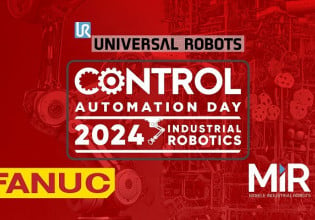J
I have two 1305's that turn seperate plate feeder turntables. These turntables meter material out of overhead bins onto a conveyor for mixing.
Due to increased efficiency in the use of materials, I need to slow these things down. I have 1175 rpm 1 hp motors turning a small gearbox and all works well as long as I command (via a 4-20 ma signal) the drive and motor combination above about 10 hz. Below that, the motor stops turning although current doesn't rise and the drives do not trip on overcurrent.
AB tells me that "slip" may be causing this scenario, and I used their formula for calculating it. When I entered the newer parameters, I actually had to use a higher freq. command to get the motors started.
I also wondered about high torque starting causing the problem... so I started the drive at 15 hz. and it turned the motor fine. As I incrementally dropped the command to about 7 hz. the motor stalled again. I tried eliminating the torque problem by issuing a high freq command, let the drive come to speed and slowing it down. That didn't work either.
Any suggestions as to what's wrong here would be greatly appreciated. One of these 1305's is a rev B and the other is rev C. I mention that only because I know there were some parameters added in rev C that B doesn't have.
Thanks for the help...
John Kelley
Due to increased efficiency in the use of materials, I need to slow these things down. I have 1175 rpm 1 hp motors turning a small gearbox and all works well as long as I command (via a 4-20 ma signal) the drive and motor combination above about 10 hz. Below that, the motor stops turning although current doesn't rise and the drives do not trip on overcurrent.
AB tells me that "slip" may be causing this scenario, and I used their formula for calculating it. When I entered the newer parameters, I actually had to use a higher freq. command to get the motors started.
I also wondered about high torque starting causing the problem... so I started the drive at 15 hz. and it turned the motor fine. As I incrementally dropped the command to about 7 hz. the motor stalled again. I tried eliminating the torque problem by issuing a high freq command, let the drive come to speed and slowing it down. That didn't work either.
Any suggestions as to what's wrong here would be greatly appreciated. One of these 1305's is a rev B and the other is rev C. I mention that only because I know there were some parameters added in rev C that B doesn't have.
Thanks for the help...
John Kelley






